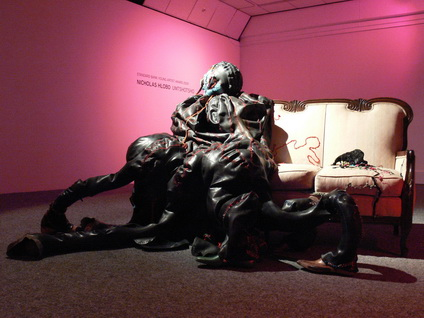Writing: Reviews & Think Pieces
Umtshotsho
Nicholas Hlobo at Monument Gallery
By Ruth Simbao

Nicholas Hlobo
Izithunzi, 2009. Rubber inner tube, ribbon, organza, lace, found objects, steel, couch detail of one of eight sculptures.
'Enjoy dancing around the figures', urges Hlobo, as he gestures towards his installation Izithunzi, which is part of 'Umtshotsho', the artist’s Standard Bank Young Artist’s exhibition at the National Arts Festival in Grahamstown. Izithunzi consists of eight robe-like sculptures—or characters, says the artist—that are made of rubber inner tubes, ribbons, organza and lace. Seven of these characters cluster together on one side of the room, while a single figure sinks into a couch.
The scene is umtshotsho, a traditional Xhosa youth party that encourages young girls and pre-initiation boys to safely explore their curiosity of adulthood by playing at war and love through performances of stick-fighting and non-penetrative ‘thigh-sex’ (ukusoma). Umtshotsho is a tradition, though, that Hlobo has never experienced. It is something that he says he does not really understand, but has heard about through stories; stories that submerge his characters in myth as they stand poised for movement like ethereal underwater sea creatures.
As such, Hlobo’s exploration of Xhosa tradition itself is playful and performative, for it is a tradition that does not easily embrace the gay identity that is so pertinent to his life and his work.
Parties, he says, are social gatherings about performing—about trying to fit into a group, trying to belong. The character on the couch is positioned to the side, perhaps shy, or awkward with its multiple wooden feet that don’t dance. Next to it a black ball mask is stitched into the couch—held down (or held back) by delicate tendrils clinging to the safety of the seat. The holes for the eyes are stitched closed. There is no seeing through the masquerade, and behind the blue mask of the seated character, there are no eyes.
As we attempt to belong, says Hlobo, we always use masks. Parties, like life, are about masquerade. Politics too. We are a young democracy, he suggests. Like the girls and boys of umtshotsho we are not yet adolescents, and we dance around each other masquerading in our political correctness. But as Hlobo dances with his characters he celebrates. He relives the umtshotsho he has never lived, celebrating the freedom of his identity; a freedom, he warns, that is not guaranteed to last. The fragility of this freedom is revealed in the material of the robes, for inner tubes are dying out, and this eventual redundancy suggests possible death.
The word 'izithunzi' means shadows. As such, the characters that seem to move and dance around the viewer create an intangible masquerade, a performance that cannot be grasped. 'I am looking for the source of the shadow' says Hlobo, but 'it keeps moving. The thing is moving away and I am chasing it.' The thing that keeps moving, he explains, is his ethnic culture, a culture that he does not fully understand, for, like all traditions, it is fluid, fleeting, twirling, dancing. It is a culture that he fears losing (especially when he catches himself dreaming in English), but it is also a culture that, in the past, drove him underground, hence the dreamlike quality of an underwater scene.
There is beauty and danger in culture as well as tradition, and this tension is reflected in Kubomvu, the installation of a lamp that is placed on a table next to the couch. A red light shines through the rubber shade, suggesting at once a warm romance, an underground scene (a red-light district), a warning ('Ubomvu!'—an expression used when the police are coming), and a protection (a condom). It is in the glow of this light that we are invited to dance amidst the shadows. 'Enjoy dancing around the figures', says Hlobo, inviting the viewer to her or his own umtshotsho: a party of experiment where the viewer plays at adulthood, plays at ‘real’ life, performs politics, and masquerade at the ball of culture.
Dance with your traditions, your identities, your shadows, 'Umtshotsho' suggests.
This article was first published in Artthrob
Ruth Simbao is the National Research Foundation SARChI Chair in Geopolitics and the Arts of Africa and a Professor in the Fine Art Department at Rhodes University, South Africa
Last Modified: Wed, 16 Aug 2017 08:26:49 SAST
